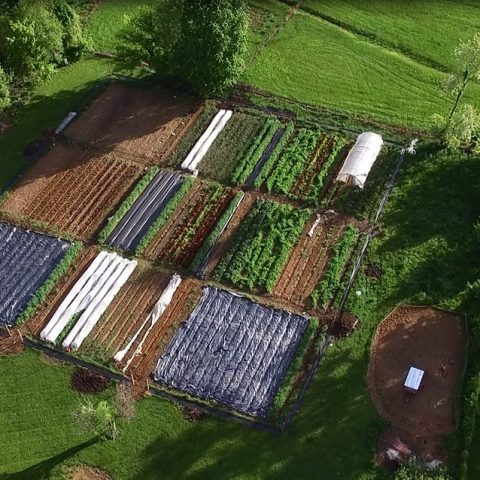Market gardener and organic farmer, Jared Gulliford, wrote this article for us that talk about the benefit of cover crops and how they’re helping his soil ecology.
By Jared Gulliford, Earth First Farm
Recently, I have found myself experimenting with various cover crops and decomposition techniques in my ½ acre market garden.
Green Manure
Cover crops, also called green manure crops, protect the soil over the harsh winter, as well as add much needed nitrogen and/or organic matter.
A main obstacle to cover crops for the home gardener is proper decomposition. The abundance of organic matter can often hinder more than help if not broken down correctly, withholding nitrogen from crops and greatly affecting yield.
Without a flail mower, I had previously thought that cover crops did not have a place in an intensive garden. Last winter, I grew separate plots of a rye, crimson clover, and winter peas.
Austrian Winter Peas – Cover Crop
With spring rapidly approaching and a greenhouse full of seedlings, I grew nervous looking out on the field of lush growth, the rye plot (slated for my summer tomatoes and peppers) was nearly 6 feet tall.
However, in just two weeks I had fully decomposed the rye and had all my peppers and tomatoes planted on schedule.
Rapid Decomposing of Rye Cover Crop
Crossing my fingers, I mowed the cover crops with a weedeater and covered them with a 6 mil silage tarp. Peeling back the tarps two weeks later, revealed clean beds ready to be worked and amended!
The rye acted like mulch between the rows and the tarp knocked back the rye root system enough to be broad forked and tilled. Ideally, with proper equipment (more powerful tiller and a flail mower) the beds would have been tilled and then tarped, letting the weed seeds germinate for a stale seed bed at the end of two weeks.
Alas, as I am only in my second season and began with a very limited budget, I do not yet have the luxury of such equipment, but hope to upgrade in the future. However, with basic equipment: a small tiller, weedeater, and silage tarps, even the home gardener can afford the joys and benefits of cover crops.
Hoophouse Greenhouse
Jared built a hoop house for $500 using old materials.
“Hoop house number two (32 ft) seems to be snow worthy. I divided a used 14 x 96 ft hoop house into two structures. Using rusty hoops and used plastic, it cost $500 dollars.”


Here, Jared demonstrates a nifty tool for removing snow from his hoop house. He said he’s happy with the Avalanche snow rake which is 4x faster than a broom. “Worth the 120 dollars!”
Hoop House Greenhouse Kits
Hoophouse greenhouse kits are a popular seller amongst the GardensAll audience. If you don’t have access to used materials as Jared did, you might try a hoop house kit. This greenhouse kit is almost the size of Jared’s.
We spoke with Jared on how he’s transformed his lawn into a market garden. You can catch that article and video interview here.
Here’s a list of Amazon’s Best Seller Greenhouse Kits.
Your can see how to build a cattle panel greenhouse here.
More on cover crops great for soil and for pollinator flowers for bees!
Happy Planting!
I’m LeAura Alderson, a garden, herb and plant enthusiast with a passion for discovering the many edible and medicinal benefits of the plants all around us, including the weeds! I’m a writer, editor and media publisher for our family of websites.
While I was certified in fitness and life coaching, I am NOT a health practitioner. However, I’m a lifelong health enthusiast, with a keen interest in healthy, organic foods and making home remedies and the content we share is from our own experience and usage as well as that extracted from scientific research so that you can explore further on your own.
Always seek the advice and guidance of your health practitioners first and foremost.
As a family we’re steadily expanding our gardening, experimentation and knowledge around all things gardening, edible landscaping, fresh organic foods and self sustainability with farming in our future. I also own and manage iCreateDaily.com, a site all about transformation through creation, and the power of positivity, optimism and mindset.

